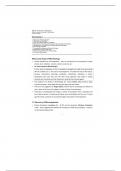MIB151: Introduction to Microbiology
Cape Peninsula University of Technology
Lecture 1 Notes
Microbiology 1
1.1 Discovery of Microorganisms
1.2 Spontaneous Generation
1.3 The role of Microorganisms in Disease
1.4 Recognition of the relationship between Microorganisms and Disease
1.5 Development of Techniques for Studying Microbial Pathogens
1.6 Immunological Studies
1.7 Industrial Microbiology and Microbial Ecology
1.8 Classification of Microorganisms
1.9 The Scope and Relevance of Microbiology
1.10 Future of Microbiology
________________________________________________________________
History and Scope of Microbiology
Society benefits from microorganisms – they are necessary for the production of bread,
cheese, beer, antibiotics, vaccines, vitamins, enzymes, etc.
So, what exactly is Microbiology?
It is the study of organisms (<1mm in diameter) and agents too small to be seen clearly
with the unaided eye, i.e. the study of microorganisms. It includes the study of their shape,
structure, reproduction, physiology, metabolism, classification, distribution in nature,
relationships with each other and with other living organisms, their ability to change
physically and chemically and their reactions to physical and chemical agents.
The subjects to be studied in Microbiology are: viruses ( theory only), bacteria, algae,
fungi and protozoa. Some algae and fungi are larger and quite visible.
This led to the suggestion by Roger Stanier , that the field of microbiology be defined not
only in terms of the size of its subjects, but also in terms of its techniques.
Practically, a microbiologist first isolates a specific microorganism from a population and
then cultures (grows) it, employing techniques such as sterilisation and the use of culture
(growth) media, necessary for successful isolation and growth of microorganisms.
1.1 Discovery of Microorganisms
Roman philosopher, Lucretius (98 – 55 BC) and the physician, Girolamo Fracastoro
(1478 - 1553) suggested that disease was caused by invisible living creatures – however,
not all scientists believed this.
1
, MIB151: Introduction to Microbiology
Cape Peninsula University of Technology
Lecture 1 Notes
The earliest microscopic observations were made studying bees and weevils (1625 and
1630), by Francesco Stelluti (microscope supplied by Galileo).
The 1st person to observe and describe microorganisms was the amateur microscopist,
Antony van Leeuwenhoek (1632 – 1723) of Delft, Holland.
Most of his spare time was spent constructing simple microscopes composed of double
convex lenses held between two silver plates, which could magnify objects around 50 to
300 times.
With his microscope, Leeuwenhoek could see both bacteria and protozoa.
1.2 Spontaneous Generation
The big idea was that living organisms can develop from non-living matter.
This view was challenged by:
Francesco Redi (1626 - 1697) – performed experiments on the ability of decaying meat to
spontaneously produce maggots.
He placed meat in three containers
Flies laid their eggs on uncovered meat and maggots developed.
Maggots did not spontaneously develop on the covered meat.
Flies laid their eggs on the gauze, where maggots developed.
Spontaneous generation was disproved, because it was shown that the maggots
developed as a result of the presence of flies.
2




